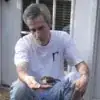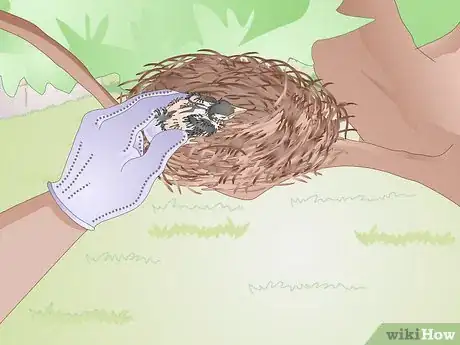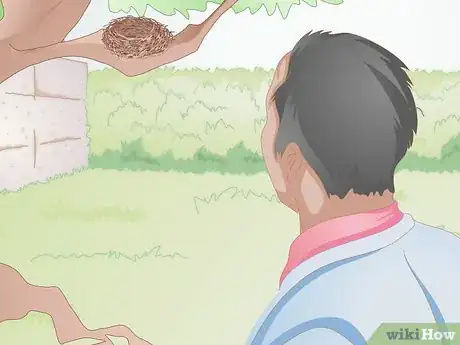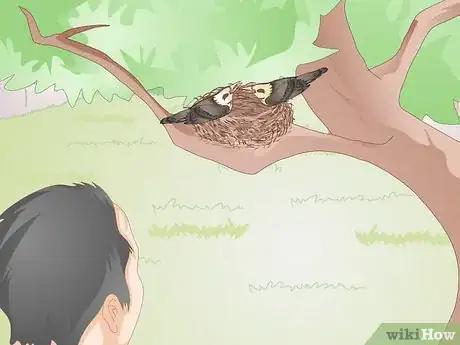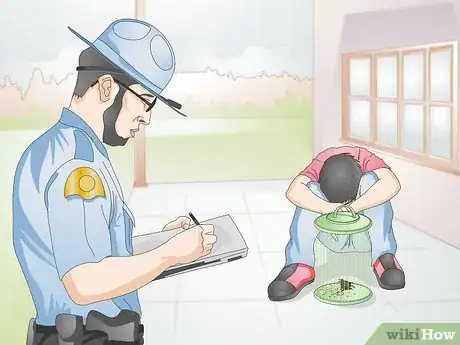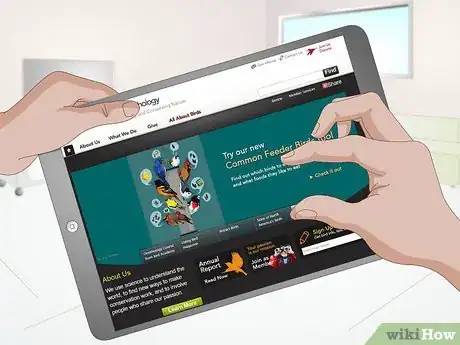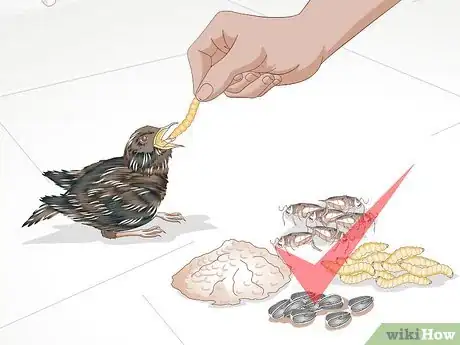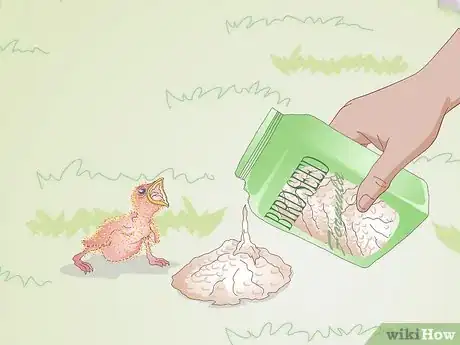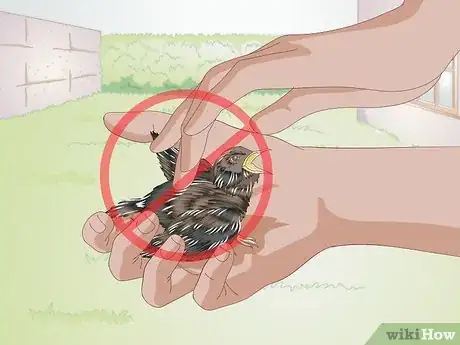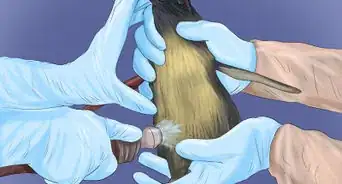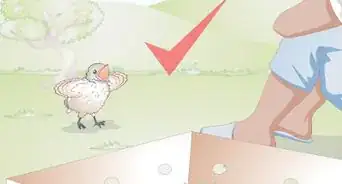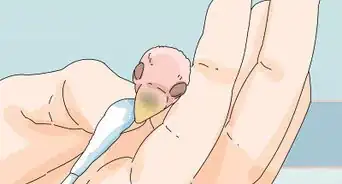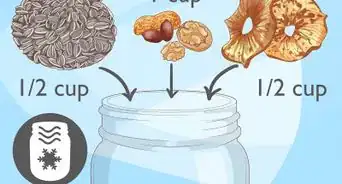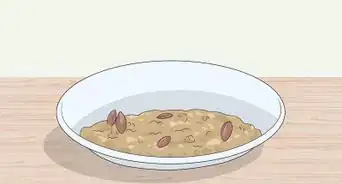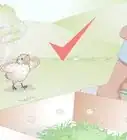This article was co-authored by Jeff Jones. Jeff Jones is a Bird Specialist based in Nashville, Tennessee. He is the writer of BirdOculars, a website dedicated to helping people become better birders. He has over 18 years of experience and specializes in feeding birds and wildlife. Jeff experiments to find ways to encourage birds he wants to study and his website help others to do the same.
There are 15 references cited in this article, which can be found at the bottom of the page.
wikiHow marks an article as reader-approved once it receives enough positive feedback. This article received 18 testimonials and 100% of readers who voted found it helpful, earning it our reader-approved status.
This article has been viewed 442,161 times.
Most people forget that baby birds are actually wild animals. The best solution for a wild animal is almost always to leave it alone, especially since it is illegal to keep wild birds in your home. However, if you must take it in or feed it, this article will provide you with the information you need to care for it.
Steps
Deciding If the Baby Bird Needs Help
-
1Put on gloves. If you plan on touching the bird, use gloves. Gloves will protect you from the bird. Even young birds can use their beaks to peck you.[1]
- There's a myth that touching a baby bird will transfer your human scent to it, causing the mother to reject it, but that's actually not the case.[2]
-
2Check for feathers. If a baby bird has feathers, it's a fledgling. If it doesn't, it's a nestling.[3]Advertisement
-
3Leave fledglings alone.[4] Fledglings have good reason to be outside the nest. If a bird is fully feathered, it's likely learning to fly. They are supposed to be out of the nest. The parents will still feed it even on the ground.[5]
- Use the finger test if you're unsure. If you can't decide whether you have a fledgling or a nestling, try letting the bird sit on your finger. If the bird can grip adequately, it's likely a fledgling.[6]
- Many young birds are left alone by parents on purpose in between feeding them. This way they don’t attract attention to them.[7]
-
4Return nestlings to the nest. Nestlings are more likely to need help. If you find a nestling, you can return it to its nest, which should be close by. If you can't find a nest, you may need to find it help.[8]
- Try listening for the siblings. When the parents return with food, you should be able to find the nest fairly easily by following the sound of the nestlings begging to be fed.
- To catch a nestling, approach the bird with one hand over the head and back and one hand under the belly and legs. Do not worry that the mother will reject the bird because you have handled her baby. She will readily accept it back into her nest.
- Warm the nestling by cradling it in your hands until the bird no longer feels cool to your touch.[9]
-
5Check the other baby birds. If you do find the nest and the other nestlings are dead, you can safely conclude that the nest has been abandoned, and you will have to take in the surviving nestling(s).
-
6
-
7Create a makeshift nest. The nest may have been destroyed by storms, a predator, or humans. If you can't find the nest, create your own. You can use a small plastic container. Line it with something soft, such as a washcloth or small towel or blanket.[12]
- Place the nest in a shady spot near where you found the bird. You can nail it to the tree. Set the bird inside, making sure to place its feet under its body.[13]
-
8Wash your hands. Always wash your hands after handling a bird. Birds can carry diseases, so it's best to thoroughly clean your hands when you're done.[14]
Knowing When to Call for Help
-
1Check for the bird's parents. If the parents don't return to the nest within a couple of hours or if you're sure the parents are not alive anymore, you'll need to call for help for the bird.[15]
-
2Look for injuries. If the bird has trouble moving or flapping its wings, it's likely injured. Also, if the bird is shivering, it may be in trouble. An injured bird is also a reason to make a call.[16]
-
3Don't try to raise it yourself. It's actually illegal to keep and raise a wild bird. You must have special permits from both the local and federal governments to raise wild animals.[17]
-
4Call a wildlife rehabilitator.[18] Wildlife rehabilitators have the skills and training to care for baby birds. You can find one on your local government's wildlife websites, or you can try calling a local veterinarian or animal shelter, as they may know rehabilitators in the area.[19] It's better to take the bird to a wildlife rehabilitator than to try and feed it yourself.[20]
- Ask for advice on how to keep the baby bird safe and warm.
Identifying and Feeding the Bird
-
1Understand the risks. Remember that by keeping the bird, you are performing an illegal act. Also, you likely do not have the expertise to feed the bird properly, so it very well may die under your care. Also, caring for a baby bird is not easy, as it needs to be fed every 20 minutes or so. Finally, you are not equipped to teach the bird what its parents do, such as how to hunt for food or how to be on the lookout for predators.[21]
- The bird also may become so accustomed to humans that it may come to harm because it doesn't know to fly from humans and may come to expect its food from humans at all times.[22]
-
2Identify the type of bird. You may be able to match the species by looking at an online field guide such as The Cornell Lab of Ornithology [23] or the Audubon Society's Guide to North American Birds.[24]
- Positive identification will be easier if you catch a glimpse of the parents. However, if the parents are still around, you should let them take care of the baby. They have strong instincts to care for their young and are well equipped to do so.
-
3
-
4Get commercial wild bird food for the best results. If you're determined to feed the baby bird or aren't able to immediately take it to a wildlife rehabilitation center, run over to your local pet store. Find formula or food made for the type of baby bird you're taking care of, and follow the directions on the package.[27]
-
5Use cat or dog food for an omnivore in a pinch. If your bird is an omnivore, you can try feeding it canned dog or cat food.[28] Warm the food to 104–106 °F (40–41 °C). Use a small spoon with the sides bent up and inward to feed the bird when its crop is empty. Don't try to force the bird to eat if it doesn't seem interested, as this could cause aspiration.[29]
- Mix and heat new food for each feeding.
-
6Feed birdseed formula to herbivores. If your bird eats seeds alone, use seed formula, which you can find at a pet store. Pet stores often carry seed formula for baby parrots.
- Use a syringe to push the food past the glottis. The glottis goes around the trachea. You'll see a small hole in the mouth or at the back of the throat where the trachea opens. You do not want to get food or water in the trachea. Therefore, make sure the tip of the syringe moves past the glottis.[30]
-
7Provide food until the baby seems full. That is, the baby will actively eat food when it is hungry. If it doesn't seem enthusiastic, it is probably full.[31]
-
8Do not provide water. If the food is sufficiently soaked, the baby bird should not need any more water, at least as long as it is a nestling. Providing water can do more damage than good, as you can cause the bird to aspirate and die.[32]
- If the bird seems dehydrated when you first take it in, you can use Gatorade or Lactated Ringers Solution. Place a drop on the bird's beak using your finger so that the bird can suck the liquid in. Signs of dehydration include a dry mouth and reddish skin. Also, the skin on the back of the neck will not spring back immediately when pinched if the bird is dehydrated.[33]
-
9
-
10Handle the bird as little as possible. To be able to release the bird, you want to make sure the bird does not imprint on you or connect with you. Limit your interactions with the bird, and do not treat it like a pet.[36]
- In fact, it's almost impossible to raise a single baby without having it imprint on you, especially if it is less than 2 weeks old.[37]
-
11Allow self-feeding at 4 weeks. At about 4 weeks old, the baby should be able to start learning to feed itself. However, it can take another month or so for that to happen. You should still hand feed during this time period, but leave a small bowl of food in the cage. At this point, you can provide a very shallow bowl of water, too.[38]
- You will notice the baby become less interested in hand-feeding over time.[39]
-
12Feed the nestling until it becomes a fledgling. You may have to wait weeks for the bird to develop its wings, becoming a fledgling. The bird cannot survive until it grows wings and starts flying on its own. Only then can you try to release it in the wild.[40]
Expert Q&A
Did you know you can get expert answers for this article?
Unlock expert answers by supporting wikiHow
-
QuestionIs it OK to hang bird feeders in trees?
 Jeff JonesJeff Jones is a Bird Specialist based in Nashville, Tennessee. He is the writer of BirdOculars, a website dedicated to helping people become better birders. He has over 18 years of experience and specializes in feeding birds and wildlife. Jeff experiments to find ways to encourage birds he wants to study and his website help others to do the same.
Jeff JonesJeff Jones is a Bird Specialist based in Nashville, Tennessee. He is the writer of BirdOculars, a website dedicated to helping people become better birders. He has over 18 years of experience and specializes in feeding birds and wildlife. Jeff experiments to find ways to encourage birds he wants to study and his website help others to do the same.
Bird Specialist I would not hang a bird feeder from a tree unless it was a squirrel-proof feeder. There’s just too many predators that can get interested in your yard if you hang feeders where they can easily get to them. If you must hang the bird feeder on a tree, keep it at least six feet from the trunk or the tree limbs.
I would not hang a bird feeder from a tree unless it was a squirrel-proof feeder. There’s just too many predators that can get interested in your yard if you hang feeders where they can easily get to them. If you must hang the bird feeder on a tree, keep it at least six feet from the trunk or the tree limbs. -
QuestionWhat do I feed an abandoned baby bird?
 Jeff JonesJeff Jones is a Bird Specialist based in Nashville, Tennessee. He is the writer of BirdOculars, a website dedicated to helping people become better birders. He has over 18 years of experience and specializes in feeding birds and wildlife. Jeff experiments to find ways to encourage birds he wants to study and his website help others to do the same.
Jeff JonesJeff Jones is a Bird Specialist based in Nashville, Tennessee. He is the writer of BirdOculars, a website dedicated to helping people become better birders. He has over 18 years of experience and specializes in feeding birds and wildlife. Jeff experiments to find ways to encourage birds he wants to study and his website help others to do the same.
Bird Specialist
-
QuestionWho can I call to take care of a baby bird?
 Pippa Elliott, MRCVSDr. Elliott, BVMS, MRCVS is a veterinarian with over 30 years of experience in veterinary surgery and companion animal practice. She graduated from the University of Glasgow in 1987 with a degree in veterinary medicine and surgery. She has worked at the same animal clinic in her hometown for over 20 years.
Pippa Elliott, MRCVSDr. Elliott, BVMS, MRCVS is a veterinarian with over 30 years of experience in veterinary surgery and companion animal practice. She graduated from the University of Glasgow in 1987 with a degree in veterinary medicine and surgery. She has worked at the same animal clinic in her hometown for over 20 years.
Veterinarian Contact a local Wildlife Rehabilitator or ASPCA officer, who is best equipped to take care of the bird. To find one near you, look online for regional directories such as http://wildliferehabinfo.org/, or phone your local vet clinic, who should have details of organizations in your area who can help.
Contact a local Wildlife Rehabilitator or ASPCA officer, who is best equipped to take care of the bird. To find one near you, look online for regional directories such as http://wildliferehabinfo.org/, or phone your local vet clinic, who should have details of organizations in your area who can help.
Warnings
- Make sure you know also what foods the bird can't eat, as some foods are not good for certain types of birds. For instance, most birds can't tolerate milk.⧼thumbs_response⧽
References
- ↑ http://www.rspca.org.uk/adviceandwelfare/wildlife/orphanedanimals/youngbirds
- ↑ https://www.audubon.org/news/when-you-should-and-should-not-rescue-baby-birds
- ↑ http://www.rspca.org.uk/adviceandwelfare/wildlife/orphanedanimals/youngbirds
- ↑ Jeff Jones. Bird Specialist. Expert Interview. 13 May 2021.
- ↑ http://www.rspca.org.uk/adviceandwelfare/wildlife/orphanedanimals/youngbirds
- ↑ http://www.birds.cornell.edu/AllAboutBirds/faq/master_folder/attracting/challenges/orphaned
- ↑ Jeff Jones. Bird Specialist. Expert Interview. 13 May 2021.
- ↑ http://www.rspca.org.uk/adviceandwelfare/wildlife/orphanedanimals/youngbirds
- ↑ http://wildlifecenter.org/baby-bird
- ↑ Jeff Jones. Bird Specialist. Expert Interview. 13 May 2021.
- ↑ http://www.birds.cornell.edu/AllAboutBirds/faq/master_folder/attracting/challenges/orphaned
- ↑ http://wdfw.wa.gov/conservation/health/rehabilitation/baby_birds.html
- ↑ http://wdfw.wa.gov/conservation/health/rehabilitation/baby_birds.html
- ↑ http://wdfw.wa.gov/conservation/health/rehabilitation/baby_birds.html
- ↑ http://wdfw.wa.gov/conservation/health/rehabilitation/baby_birds.html
- ↑ http://wdfw.wa.gov/conservation/health/rehabilitation/baby_birds.html
- ↑ http://wildlifecenter.org/baby-bird
- ↑ Jeff Jones. Bird Specialist. Expert Interview. 13 May 2021.
- ↑ http://wildlifecenter.org/baby-bird
- ↑ https://www.audubon.org/news/when-you-should-and-should-not-rescue-baby-birds
- ↑ http://www.birds.cornell.edu/AllAboutBirds/faq/master_folder/attracting/challenges/orphaned
- ↑ http://www.birds.cornell.edu/AllAboutBirds/faq/master_folder/attracting/challenges/orphaned
- ↑ http://www.allaboutbirds.org/guide/search
- ↑ http://birds.audubon.org/birdid
- ↑ http://www.allaboutbirds.org/guide/Northern_Cardinal/lifehistory
- ↑ http://www.allaboutbirds.org/guide/American_Crow/lifehistory#at_food
- ↑ https://vcahospitals.com/know-your-pet/hand-feeding-baby-birds
- ↑ https://www.rspb.org.uk/birds-and-wildlife/advice/how-you-can-help-birds/feeding-birds/safe-food-for-birds/
- ↑ https://vcahospitals.com/know-your-pet/hand-feeding-baby-birds
- ↑ http://www.themodernapprentice.com/trachea.htm
- ↑ http://www.2ndchance.info/insecteater.htm
- ↑ http://www.2ndchance.info/insecteater.htm
- ↑ http://www.starlingtalk.com/babycare.htm
- ↑ https://vcahospitals.com/know-your-pet/hand-feeding-baby-birds
- ↑ http://www.birds.cornell.edu/AllAboutBirds/faq/master_folder/attracting/challenges/orphaned
- ↑ http://www.starlingtalk.com/babycare.htm
- ↑ http://www.starlingtalk.com/babycare.htm
- ↑ http://www.starlingtalk.com/babycare.htm
- ↑ http://www.starlingtalk.com/babycare.htm
- ↑ http://www.birds.cornell.edu/AllAboutBirds/faq/master_folder/attracting/challenges/orphaned
- ↑ http://www.starlingtalk.com/babycare.htm
- ↑ http://www.starlingtalk.com/babycare.htm
About This Article
If you want to feed a wild baby bird, examine the bird’s size, coloring, and the shape of its beak to identify what kind of bird it is. Once you’ve identified the bird, look up the type of food that species eats in the wild. If the bird is naturally an omnivore, feed it dog or cat food that’s been softened with a little water. If the bird is an omnivore, purchase seed formula from a local pet store and feed it to the baby bird with a syringe. For tips from our veterinary reviewer on whether or not to move a baby bird, keep reading!



